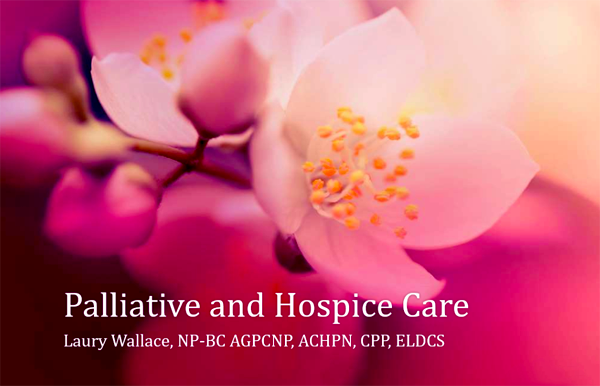
The Putnam County Hospice and Palliative Care Association (PCHPCA) is seeking to offer a high-quality educational video library for use by healthcare professionals and the general public.
Please click on the links below to view the video presentations.

Presented by: Brian Black, D.O.
Family Physician, Greencastle Family Health (Hendricks)
Medical Director – Elara Caring Hospice

Produced by PCHCPA Board Member Laury Wallace, NP-C, AGPCNP. ACHPN, CPP ELDCS
Owner/Nurse Practitioner
Life's Journey Home Hospice & Inpatient Hospice Facility
Anyone can inquire about hospice services. You or your loved one may call a local hospice provider and request services. The hospice staff will then contact your physician to determine if a referral to hospice is appropriate. Another way to inquire about hospice is to talk with your physician, and he or she can make a referral to hospice.
There are a number of hospice providers serving Putnam County. While they have many things in common, each provider is also unique. It is important to find out about the services that each hospice offers.
You can also talk to people you trust who work in healthcare or aging services or who have received support from a hospice.
Resources:
PCHPCA Choosing a Hospice Questionnaire
Hospice Providers Serving Putnam County 2024-2025 - PCHPCA
Choosing a Hospice Provider Worksheet – CaringInfo
How to Choose a Hospice – Indiana Hospice and Palliative Care Organization
Choosing a Hospice: 17 Questions to Ask – Hospice Foundation of America
Palliative care is whole-person and family-centered care that relieves symptoms of a disease or disorder, whether or not it can be cured. Hospice is a specific type of palliative care for people who likely have six months or less to live. Hospice care is always palliative care, but not all palliative care is hospice care.
Both palliative care and hospice care seek to improve the quality of life for both the patient and family. But palliative care can begin at diagnosis and continue along with treatment. Hospice care begins after treatment of the disease is stopped, and when it is clear that the person is not going to survive the illness.
Resources:
Some Differences Between Hospice Care and Palliative Care - NIH
Palliative Care and Hospice Care Handout - CaringInfo
Palliative and Hospice Care: What’s the Difference
“I wish we had been referred to hospice sooner.” It’s a sentiment that recurs in patient/family surveys returned to hospices each year. Unfortunately, most people don't receive hospice care until the final weeks or even days of life, possibly missing out on months of quality time. This may be out of fear that choosing hospice means “giving up.” Sometimes doctors fear that their patients will feel abandoned if they suggest hospice.
Experts in hospice care agree that patients need to be enrolled for at least 60 days to take full advantage of a hospice program. Sadly, while hospice care is most effective over a period of months, the 2018 National Hospice and Palliative Care Organization Report indicated that nearly 28% of Medicare hospice recipients received services for seven days or less. Here are some of the benefits of timely referral to hospice:
- The patient can participate in all planning and decisions, before the stress of a medical crisis. Early discussions about hospice can facilitate open communication and provide patients and their family members a choice and sense of control.
- Patients and family benefit from sustained relationships with the hospice team. They have time to develop personal and professional rapport with staff and volunteers, discuss end-of-life goals and create an optimal plan of care designed around patient and family wishes.
- Pain and symptoms are addressed sooner, and crises can be avoided.
- Hospitalizations can be reduced or eliminated.
- Advance directives can be prepared to avoid difficult decisions later.
- Hospice services can help a patient and family spend peaceful time together. It offers a comforting alternative when a cure is no longer possible.
- Hospice can eliminate unnecessary calls to 911 and trips to the emergency room by giving families the means to care for their loved one at home and the knowledge of what to expect at the end of life.

Putnam County Hospital
1542 S. Bloomington Street
Greencastle, IN 46135
T: 765.301.7614
E: This email address is being protected from spambots. You need JavaScript enabled to view it.



